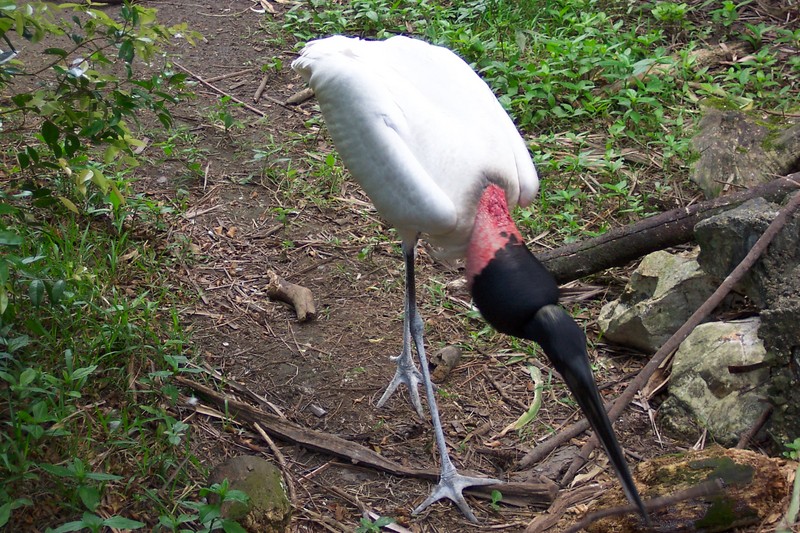|
| Query: jabiru | Result: 2nd of 42 | |
Jabiru (Jabiru mycteria) - Wiki
| Subject: | Jabiru (Jabiru mycteria) - Wiki
| |

| Resolution: 1800x1200
File Size: 957835 Bytes
Date: 2004:02:25 13:54:56
Camera: KODAK DX4330 DIGITAL CAMERA (EASTMAN KODAK COMPANY)
F number: f/4.0
Exposure: 1/60 sec
Focal Length: 187/10
Upload Date: 2007:10:23 17:52:08
|
Jabiru
From Wikipedia, the free encyclopedia
[Photo] Jabiru (Jabiru mycteria): A Jabiru stork, taken at the Belize Zoo. Date 25 February 2004. Author http://en.wikipedia.org/wiki/User:1000Faces This image was taken by me, with my camera, and is released to the public domain.
The Jabiru (Jabiru mycteria) is a large stork found in the Americas from Mexico to Argentina, except west of the Andes. It is most common in the Pantanal region of Brazil and the Eastern Chaco region of Paraguay. It is the only member of the genus Jabiru. The name comes from the Tupi-Guaran?? language and means "swollen neck".
The name Jabiru has also been used for two other birds of a distinct genus: the Asian Black-necked Stork (Ephippiorhynchus asiaticus), commonly called "Jabiru" in Australia; and sometimes also for the Saddle-billed Stork (Ephippiorhynchus senegalensis) of sub-Saharan Africa. In particular, Gardiner's's Egyptian hieroglyph G29, believed to depict an E. senegalensis, is sometimes labeled "Jabiru" in hieroglyph lists.
In Portuguese, the bird is called jabiru, jaburu, tuiui??, tuim-de-papo-vermelho ("red-necked tuim", in Mato Grosso) and cauau?? (in the Amazon Basin). The name tuiui?? is also used in southern Brazil for the Wood Stork (Mycteria americana).
The proposed Late Pleistocene fossil stork genus Prociconia from Brazil might actually belong into Jabiru. A fossil species of jabiru was found in the early Pliocene Codore Formation near Urumaco, Venezuela; it has not yet been described (Walsh & S??nchez 2005).
Description
The Jabiru is the tallest flying bird found in South America, often standing around the same height as the flightless and much heavier American Rhea. The adult size of Jabirus ranges up to 1.5 m (5 ft) tall, 2.8 m (9.2 ft) across the wings, and a weight of at least 8 kg (17.6 lbs). The beak, up to 30 cm (1 foot) long, is black and broad, slightly upturned, ending in a sharp point. The plumage is mostly white, but the head and upper neck are featherless and black, with a featherless red stretchable pouch at the base. The sexes are similar, although the female is usually smaller than the male. While it is an ungainly bird on the ground, the Jabiru is a powerful and graceful flier.
Habits
The Jabiru lives in large groups near rivers and ponds, and eats prodigious quantities of fish, mollusks, and amphibians. It will occasionally eat reptiles and small mammals. It will even eat fresh carrion and dead fish, such as those that die during dry spells, and thus help maintain the quality of isolated bodies of water.
The nest of twigs is built by both parents around August???September (in the southern hemisphere) on tall trees, and enlarged at each succeeding season growing to several meters in diameter. Half a dozen nests may be built in close proximitiy, sometimes among nests of herons and other birds. The parents take turns incubating the clutch of 2 to 5 white eggs.
http://en.wikipedia.org/wiki/Jabiru
| The text in this page is based on the copyrighted Wikipedia article shown in above URL. It is used under the GNU Free Documentation License. You may redistribute it, verbatim or modified, providing that you comply with the terms of the GFDL. |
|
Comments |
|---|
| | Guest |
|
Jabiru mycteria
Jabirus are found in the Western Hemisphere, as far north as Mexico and as far south as Argentina. They are most common found in wetland regions of Brazil and Paraguay. Jabiru have been spotted in Argentina, Belize, Bolivia, Brazil, Columbia, Costa Rica, Ecuador, El Salvador, French Guiana, Grenada, Guatemala, Guyana, Honduras, Mexico, Nicaragua, Panama, Paraguay, Peru, Suriname, Trinidad and Tobago, Uruguay, and Venezuela, with rare sightings as far north as Texas. |
| | Guest |
|
Scientific Name: Jabiru mycteria (Lichtenstein, 1819)
Common Names: Jabiru, Jabiru Stork
French: Jabiru d’Amérique; German: Jabiru; Spanish: Jabirú americano, Cigüeña jabirú
Taxonomy: Ciconia mycteria M. H. C. Lichtenstein, 1819, Brazil. |
^o^
Animal Pictures Archive for smart phones
^o^
|
|
|

